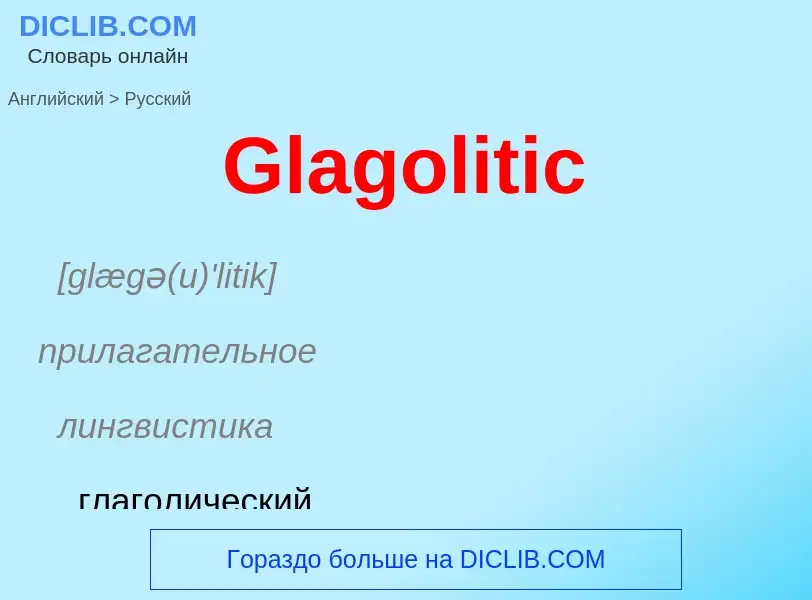Translation and analysis of words by ChatGPT artificial intelligence
On this page you can get a detailed analysis of a word or phrase, produced by the best artificial intelligence technology to date:
- how the word is used
- frequency of use
- it is used more often in oral or written speech
- word translation options
- usage examples (several phrases with translation)
- etymology
Glagolitic - translation to russian
[glægə(u)'litik]
прилагательное
лингвистика
глаголический
относящийся к глаголице
существительное
[glægə(u)'litik]
лингвистика
глаголица
Definition
Wikipedia
The Glagolitic script (, ⰳⰾⰰⰳⱁⰾⰹⱌⰰ, glagolitsa) is the oldest known Slavic alphabet. It is generally agreed to have been created in the 9th century by Saint Cyril, a monk from Thessalonica. He and his brother Saint Methodius were sent by the Byzantine Emperor Michael III in 863 to Great Moravia to spread Christianity among the West Slavs in the area. The brothers decided to translate liturgical books into the contemporary Slavic language understandable to the general population (now known as Old Church Slavonic). As the words of that language could not be easily written by using either the Greek or Latin alphabets, Cyril decided to invent a new script, Glagolitic, which he based on the local dialect of the Slavic tribes from the Byzantine theme of Thessalonica.
After the deaths of Cyril and Methodius, the Glagolitic alphabet ceased to be used in Moravia for political or religious needs. In 885, Pope Stephen V issued a papal bull to restrict spreading and reading Christian services in languages other than Latin or Greek. Around the same time, Svatopluk I, following the interests of the Frankish Empire, persecuted the students of Cyril and Methodius and expelled them from Great Moravia. In 886, Clement of Ohrid (also known as Kliment), Naum, Gorazd, Angelar and Sava arrived in the First Bulgarian Empire where they were warmly accepted by the Tsar Boris I of Bulgaria. Both the Glagolitic and Cyrillic alphabets were used until 13th-14th century in Bulgaria. The Cyrillic alphabet (which borrowed some letters from the Glagolitic alphabet) was developed at the Preslav Literary School in the late 9th century. The Glagolitic alphabet was preserved only by the clergy of Croatia and Dalmatia to write Church Slavonic until the early 19th century. Glagolitic also spread in Bohemia with traces in Pannonia, Moravia and Russia.
With the adoption of Latin and Cyrillic alphabets in all Slavic-speaking countries, Glagolitic script remained in limited liturgical use for Church Slavonic in primarily Eastern Orthodoxy and Eastern Catholic Church observance, a direct descendant of Old Church Slavonic.

![In a book printed in 1591, [[Angelo Rocca]] attributed the Glagolitic script to Saint Jerome. In a book printed in 1591, [[Angelo Rocca]] attributed the Glagolitic script to Saint Jerome.](https://commons.wikimedia.org/wiki/Special:FilePath/Angelo Rocca Glagolitic Alphabet.jpg?width=200)

![Glagolitic script in the [[Zagreb Cathedral]] Glagolitic script in the [[Zagreb Cathedral]]](https://commons.wikimedia.org/wiki/Special:FilePath/Glagolitsa in Zagreb cathedral.jpg?width=200)
![The final Glagolitic entry in the [[Omišalj]] parish's baptismal register, by the cleric Nicholas in 1817. The final Glagolitic entry in the [[Omišalj]] parish's baptismal register, by the cleric Nicholas in 1817.](https://commons.wikimedia.org/wiki/Special:FilePath/Omišalj Baptismal Register.png?width=200)
![[[The Lord's Prayer]] shown in (from left) round, angular, and cursive versions of Glagolitic script. [[The Lord's Prayer]] shown in (from left) round, angular, and cursive versions of Glagolitic script.](https://commons.wikimedia.org/wiki/Special:FilePath/Vergleich Glagolitische Schrift.jpg?width=200)

![The first page of the Gospel of Mark from the 10th–11th century ''[[Codex Zographensis]]'', found in the [[Zograf Monastery]] in 1843. The first page of the Gospel of Mark from the 10th–11th century ''[[Codex Zographensis]]'', found in the [[Zograf Monastery]] in 1843.](https://commons.wikimedia.org/wiki/Special:FilePath/ZographensisColour.jpg?width=200)
